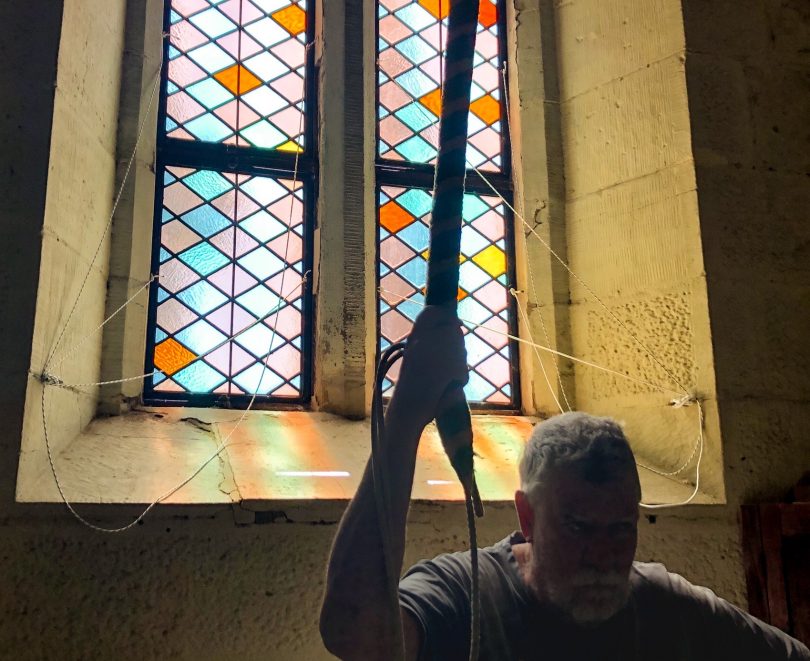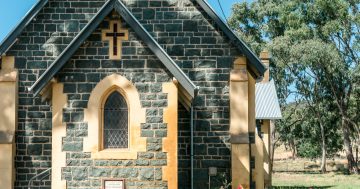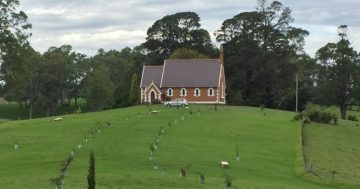
Light flows through the historic stained glass windows of St Clements Church Yass as bell-ringer Peter Rose practises his craft. Photo: Sally Hopman.
More than 30 years ago, someone suggested Peter Rose give bell-ringing a try at the historic St Clements Anglican Church in Yass.
Why not, the former public servant thought. Today, Peter is one of the mainstay bell-ringers at the Yass church, which can claim its six bells, installed in the 1850s, are the oldest of their kind in regional Australia.
But in the past three years the church bells have been bordering on the silent, pealing only for the occasional funeral and wedding.
Normally the church can seat 300 for a Sunday service, but COVID-19 put paid to much of its activity.
Until now. Peter Rose and the other bell-ringers welcome the easing of virus restrictions with an invitation to everyone to try their hands at bell-ringing.
“For the church’s six bells we need six people,” Peter said. “We have nine volunteers these days so usually if I call them, we’ll get six people in,” he joked.
“But we’d love to see more people try it. ”

St Clements is one of the oldest in the district, with church records dating back to 1839. Photo: Supplied.
Although the majority of the volunteers come from Yass, others come from outlying rural regions and Canberra.
People can learn the basics of how to ring the bell in a day, but it can take weeks, months or longer to not only feel comfortable ringing, but also to master all the mathematical permutations.
Having a mathematical bent helps, Peter said, when it comes to bell-ringing sequences. But a passion for it, is even better.
“Some people just pick it up immediately,” he said.
“They have an ear for it – and the right mind for it. Young people seem to pick it up quickly, too.”
It’s also not bad for your health. Peter said regular pulling of the bells, which can weigh hundreds of kilos, can do wonders.
“It can be strenuous, but it’s not exhausting. It’s like gently stretching, really good for a sore back,” he said.
“We had one woman ringing… she said it was great to ring for a couple of nights after shearing. She felt as right as rain afterwards.”
“It can feel like something a physio would give you to do for a bad back.”
So how does it work? Each of St Clements’ six bells is attached to a wheel that is turned by pulling on a rope, which is the simple part. One toll for a funeral is easily managed. Where it starts to get complicated is when the bell ringer must use multiple bells to create the right sequence for an occasion such as a wedding. It is up to the bell-ringer to control the wheel and the subsequent swing of the bell.

Bell-ringer Peter Rose at the door of St Clements Church, Yass. Photo: Sally Hopman.
This Saturday 19 February, people interested in learning how to ring those bells are invited to St Clements, Yass, to give it a try.
People of all ages are welcome, the main prerequisite being that, if they find they enjoy it, they stay the course.
“It’s a learning process,” Peter said. “We’re looking for people who want to learn how to do it and to stick with it. It might be just for a few minutes a few times a week, we just want people to stick with it so we can build up our team of volunteers again.”
Another of the St Clements bell-ringing stalwarts, Ted Reid, will also be on-hand on Saturday to share his skills. Ted started ringing 38 years ago because he was “fascinated by the sound of the bells”.
“Once you learn how to do it, it can become a lifetime passion,” he said.
“It can be a wonderful experience for people to come in and hear the bells – and then see how it is done.”
So what does it take to be a good bell-ringer?
“Good hand and eye skills and good sense of rhythm,” he said. He added it was not about learning music, rather it was about learning ‘method’ – the sequences required when bells peal.
Interested people are invited to try bell-ringing for themselves this Saturday, 19 February from 10am at St Clements in Church Street, Yass.
For more information, email [email protected]












